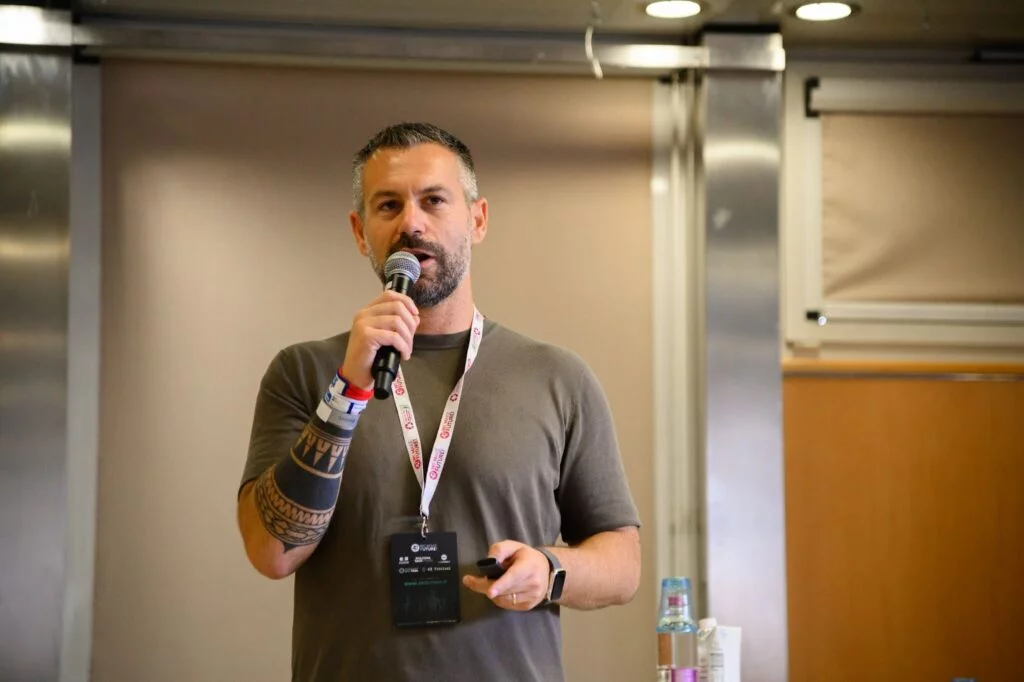How to Tell Your Brand Story in the Age of Distraction: Cristiano Carriero, La Content Academy
- by Ilona K.

Table of contents
In the times of information overload, it’s hard to get your brand’s voice heard. Cristiano Carriero, co-founder at La Content Academy, shares his tips on brand storytelling in the age of distraction in the interview with it.com Domains.
Mastering the art of storytelling is arguably one of the most important things you can do for your brand. As Steve Jobs once said, “the most powerful person in the world is the storyteller.” However, storytelling in the age of digital and artificial intelligence, when content has become a commodity, is more difficult than ever.
How to get your brand story out there when anyone can write a 8000-word text, an image or even a song in less than a minute using AI? At the We Make Future event in Bologna, Cristiano Carriero, co-founder at La Content Academy, creator of the Storytelling Festival and TedX speaker, presented his take on the topic during “The Power of Story: Building Remarkable Brands in the Digital Landscape” masterclass. We’ve asked Christiano to share advice on effective brand storytelling for businesses striving to succeed online.

Attract, Engage, Excite!
it.com Domains: How can a brand identify its unique story — the one that truly sets it apart from the competition?
Cristiano Carriero: The main challenge is to search for stories that attract, engage, excite- and the key to finding those stories is always listening. Yet not everyone is able to listen attentively to their stakeholders, customers, employees. That's where the stories usually are. I have a method that consists of a thorough audit of all stakeholders, to really understand what the essence of the brand is and what the core narrative of the company is.

it.com Domains: When building a brand story, should the focus be on the past, present, or future of the company?
CC: Of course, not all companies have a past that allows them to be considered heritage brands. Those that do have the past must safeguard it as one of the founding elements of the narrative, alongside with the present and the future, which tell us the long-term vision.
Storytelling lies in this bridge between the present and the future. Even if it is not so important to communicate the transformation of a company — which after all can remain the same - as the transformation of the people who use that product/service.
it.com Domains: What are some effective ways to translate a complex brand message into a clear and engaging narrative?
Having a great brand story is not enough — you need to turn it into a clear and engaging narrative. To do that, you have to simplify, but sometimes a poorly thought-out choice of concepts, words, images and combinatorial art leads us to be trivial - avoid that at all costs!
When you nailed down a simple message — remember that communication is a matter of rhythm, not just time. For a concept to stick, it must be repeated several times, in at least ten different ways. It is not that people do not want to listen: they are simply busy. We live in a true age of distraction - the CEO of Netflix himself says that their main competitor is sleep!
it.com Domains: For someone just starting to explore the power of storytelling, what resources would you recommend?
‘Steal like an Artist’ and ‘Newspaper Blackout’, both by Austin Kleon, are an invaluable resource, alongside Ted Talks like ‘Starting with Why’ by Simon Sinek. Be curious, listen to podcasts, get involved: there are many storytelling events to attend. Watch old commercials, the ones that wrote the history of advertising. Ask yourself why they worked and whether they would still work. If the answer is yes, it is because they contained the universality of storytelling: just like the great classics of literature and cinema.

Storydoing, not Storytelling
it.com Domains: How can storytelling be utilized to build trust and credibility with potential customers?
CC: Storytelling creates trust when it is not just a manifesto, but an action, involvement, ecosystem. If my website says that my company is sustainable, while my employees are not, I am not doing storytelling. If I say I have a vision, and the CEO of my company is unable to give an inspirational speech, I am not doing storytelling.
That is why I believe in storydoing, rather than storytelling, a plan of concrete actions to be monitored and involving all functions: HR, communication, marketing, management.
it.com Domains: What are some common mistakes brands make when it comes to storytelling, and how can these be avoided?
CC: The most common mistake brands make is to confuse it with fiction. Or to think that 'storytelling' means making a text more palatable, i.e. starting with an informative text, filling it with metaphors and expecting that to become engaging. Nothing could be more wrong.
Storytelling is a mindset and, to make it so, it must be a compass for the company. My mantra is: if you can tell it, it means it can work. I always ask my employees to tell me the story of a product or service they have to launch, or an idea they would like to turn into a business. However, beware of the narrative taking over: it’s crucial to find the right balance between the stories and the facts to maintain integrity and credibility.
it.com Domains: How can storytelling be used to not only attract new customers, but also foster loyalty among existing ones?
CC: Retaining old customers is more difficult than attracting new ones. For the latter, marketing is enough, for the former, you need a great story! In his book ‘Emotion by Design’, Greg Hoffmann, former CMO of Nike, explains how one of the company's greatest breakthroughs was to have one advertising agency building a storytelling to last and evolve.
All Nike fans feel part of a great story, represented by a brand (the swoosh) and a 'just do it' payoff. But the great story is in the commercials, in the testimonials chosen over the years, in the fight against racism and the battle for inclusion that Colin Rand Kaepernick has represented, in the very choice to be the first company to have an African American CMO.

Brand Story Online Starts With a Domain
it.com Domains: In the domain name industry, where creativity in naming is key, how can brands leverage storytelling to elevate their chosen domain?
CC: Domains are the best way to make it clear what your brand is about, what your market is, what problems you solve for people. When you start a business, worry about two things: whether the business name you’ve chosen is free and if a related domain name is available.
For example, my company is called La Content, but we are in the storytelling business and our flagship event is storytelling festival. Buying both 'storytellingfestival' and 'lacontent' domain names means taking a very important slice of the market and communicating that we want to be the reference company for storytelling.
it.com Domains: How can a domain name itself be used as a storytelling tool?
CC: Today, the domain name tells everything about our brand and our storytelling. When we see services whose domain name does not match the brand name, there is something wrong. But there are services that have created their own storytelling right from the domain name. For example, Subito.it, which then became Subito, or Facile.it, precisely gives the idea of a fast site, within everyone's reach.

Stories, not Content
it.com Domains: What are some of the different storytelling formats – blogs, videos, social media – that work best in the digital world?
CC: A few years ago it was said that blogs were going to die - but just like newsletters, they seem to be doing just fine. Podcasts and videos are on the rise, while 'static' social formats are slightly on decline. We are moving from an era where content was fast and frequent to one where content will be more elaborate, qualitative, and multiplatform. The era of frantic posting is over. People ask us for stories, not content to fill the editorial plan.
it.com Domains: When integrating storytelling with influencer marketing, how can brands identify the right influencers to tell their story authentically?
CC: Influencer marketing is an integral part of storytelling. You just have to accept that influencers are media, and should be chosen as such. Choosing an influencer presupposes a knowledge of the subject matter that not everyone has. Many think that tools are enough (I use some such as Klear, iQdata, Inflead), but that is not the case.
You have to be very up-to-date on trends, creators, the type of audience that follows them. Then you go on to assess the metrics of the individual influencer. What do I expect from him/her? What kind of audience will he/she reach? Does their activity drive awareness or product purchases? Ask those questions before working with a creator and be very clear about the story that he or she will have to tell.
it.com Domains: Metrics are indeed crucial in the digital space. How can brands track the success of their storytelling efforts?
CC: Storytelling is much more measurable than you think. Whether it is the number of site visits, or the number of members in a community, the important thing is to carefully define the journey that must lead our potential consumer to be a fan, and the metrics to evaluate success. Not all contacts are equal: a newsletter subscriber is worth more than a Facebook fan. A newsletter subscriber who, in turn, replies and comments, is worth even more.

it.com Domains: Looking ahead, what trends do you see emerging in the world of brand storytelling? What exciting possibilities lie ahead?
Today, brands are called to a great challenge, that of embracing both new technologies and the techniques of analogue storytelling, of the story capable of enchanting. There is little use in a tool that generates videos if there is no one who can write the right plot, imagine the incipit and the climax. It is a very exciting time for storytellers! Generative AI gives us many exciting opportunities, but those who can tell great stories will flourish.
Get inspired by the leading industry experts! Visit it.com Domains blog and follow us on social media.

Read also

Expert Opinion
Domains, Power and Clarity: 2026 Reading List from Andrey Insarov, CEO of it.com Domains
- 4 min read

Expert Opinion
- 5 min read
